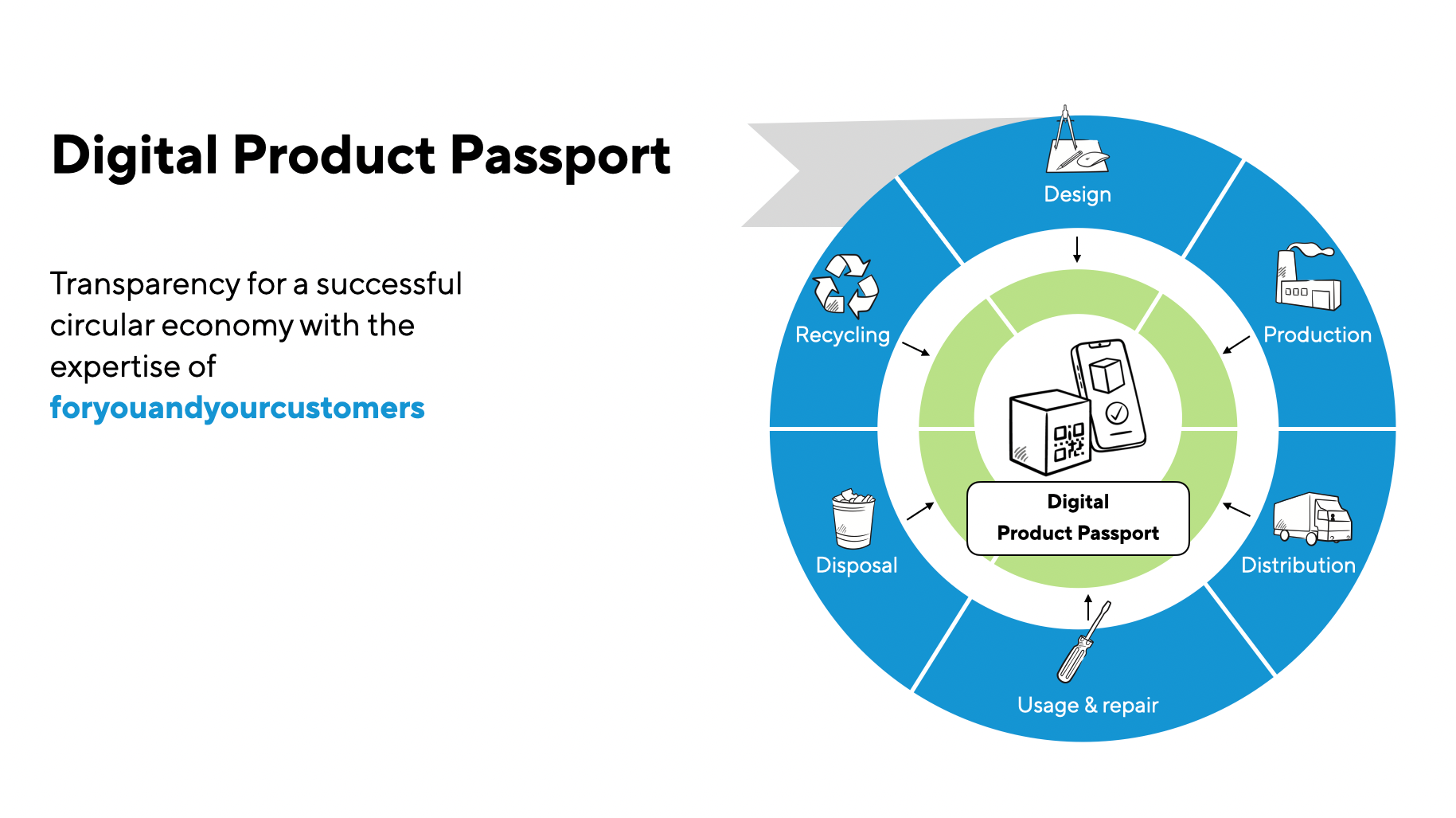Digital product passport: act early and seize opportunities

The Digital Product Passport is coming and companies should prepare for it early on. With the European Green Deal, the Circular Economy Action Plan and the Ecodesign for Sustainable Product Regulation, the EU has created a legal basis to promote sustainability and digitalization. A central element of this is the Digital Product Passport, which companies will have to offer for all products in future.
What is the Digital Product Passport?
The Digital Product Passport displays information about a product, its manufacture, material composition, supply chains, recyclability, certifications and repair information and is accessed, for example, via a QR code on the product. The aim is to increase transparency for consumers and other target groups, meet legal requirements and ultimately promote sustainable production and increase product lifespan.
Practical implementation poses challenges for companies
What sounds simple poses major challenges for companies in practice. Implementation requires cooperation between different players in the company across the entire value chain. Product development is just as affected as purchasing, production, sales, marketing or support. The question of who is responsible is often enough to cause problems.
The necessary changes affect the channel landscape, organization, processes, systems and data. This is where the Exploded View from foryouandyourcustomers can be used as an organizing tool. It is also advisable to take a proactive approach to this change process as early as possible and to make the most of the opportunities it offers with well thought-out solutions. The foryouandyourcustomers team offers guidance, pioneering solutions and partnership-based cooperation along the way.
Is your company ready for the Digital Product Passport?
From a regulatory perspective, things will get serious for the first time in February 2027 for part of the battery industry, which will have to introduce the so-called Battery Passport for larger batteries, such as those used in electric vehicles or industrial applications. This will be followed by a large number of other industries that are highly relevant to the circular economy and achieving the EU's sustainability goals, including the automotive industry, textile industry, construction industry, packaging industry, furniture industry and food and beverage industry.
However, the market is not waiting and companies are using the Digital Product Passport as an opportunity to gain a competitive advantage over the competition. Accordingly, digital product passports are already in circulation across various industries and products. To take a leading position, you should consider the following questions:
When will your company be affected by the introduction of the Digital Product Passport? Which product groups are affected and when?
Has the topic received the necessary attention in your company?
Are the effects on your company already understood, formulated and known?
Is the responsibility for the introduction of the Digital Product Passport defined?
Is the necessary data on material master, material composition, CO2 footprint, recyclability, repair options and supply chains available on a product-by-product basis?
Do you have the manufacturing capabilities to tag each individual product with a QR code or RFID chip to ensure access to the Digital Product Passport?
Do you have a solution for keeping the data persistent over the entire lifetime of the products?
Where does the competition stand?
If you are unable to answer all the questions directly, we recommend that you address the topic, for example as part of a readiness assessment.
Opportunities through early introduction of the digital product passport
An early discussion of the Digital Product Passport will first and foremost provide clarity about the need for change and the necessary investment requirements that your company will have until the mandatory introduction. Think in particular about the long-term and time-consuming changes that may be necessary in the area of data generation. The earlier these are planned, the more time companies have available for implementation.
Apart from the legal necessity, further opportunities arise:
Transparency for customers, which grants new access to the spare parts business or related services (e.g. repair service).
Positive perception of the company in terms of sustainability.
Additional purchasing arguments in the decision-making process.
Promotion of sustainability in product development, purchasing and production.
Extending the service life and improving the recyclability of products.
Preparation for regulatory requirements and audits or certifications.
Advantages over the competition.
An additional sales channel (e.g. spare parts, accessories).
7 Fields of action
Various challenges need to be solved as part of the implementation of the Digital Product Passport. This results in the following fields of action:
Strategy: Companies can strategically position the Digital Product Passport in different ways. From simple fulfillment of obligations to strategic use as part of sustainability initiatives or combination with new services, many things are conceivable. Strategic positioning of the topic creates clarity for everyone involved.
Understanding the target groups: There are various target groups that place requirements on the Digital Product Passport, e.g. politicians, consumers (B2C), customers in multi-level distribution (B2B), recyclers / recycling companies or technical service / repair. The needs of the target groups must be understood and taken into account.
Data modeling: The digital product passport should digitally represent a specific product. In individual cases, it must be decided whether an SKU is sufficient as a basis or whether the actual digital twin of the individual product produced (Digital Instance Twin) is required. This fundamental decision is followed by the specific data model that serves as the basis for the product passport.
Access & Customer Experience: Access to the digital product passport must be possible from the product, e.g. via QR code or RFID technology, as they enable broad access. This has implications for manufacturing processes and data generation, but also for the customer experience on the access device.
Date availability: The availability of the required data over the life cycle of the product must be guaranteed. This requires a large number of data points that need to be generated and persistently stored during the product development process (and sometimes also during the product usage phase). The data is available in different systems (e.g. ERP, PDM, MDM, PIM) that need to be connected. Relevant data is often not yet available.
Organisation & Processes: The digital product passport is a new channel that must have a clear responsibility within the company. In addition, various processes must be introduced or adapted within the company in order to ensure optimal data generation and product development.
Communication & Change Management: Both communication within the company during the introduction and communication to the public play a role in the introduction of the Digital Product Passport.
Implement the Digital Product Passport together with us
We would be happy to help you implement the Digital Product Passport in your company. Our newly established lab on this topic offers access to experts in the fields of consulting, IT, design, strategy and data management.
Its a pleasure for us to accompany and support you!
From the initial idea to a finished digital product. We are pleased to invite designers and decision-makers from different companies to develop the topic in a partnership-based, solution-oriented and practical manner. We look forward to your request!
